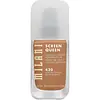What's inside
What's inside
 Key Ingredients
Key Ingredients

 Benefits
Benefits

 Concerns
Concerns

 Ingredients Side-by-side
Ingredients Side-by-side

Isododecane
EmollientWater
Skin ConditioningButylene Glycol
HumectantEthylhexyl Palmitate
EmollientTrimethylsiloxysilicate
EmollientPolymethylsilsesquioxane
PEG-10 Dimethicone
Skin ConditioningC24-28 Alkyldimethylsiloxy Trimethylsiloxysilicate
Skin ProtectingDimethicone
EmollientPolysilicone-11
Octyldodecyl Stearoyl Stearate
EmollientPEG/PPG-18/18 Dimethicone
EmulsifyingPolyethylene
AbrasiveTropaeolum Majus Flower/Leaf/Stem Extract
Skin ConditioningPhenoxyethanol
PreservativeEthylhexylglycerin
Skin ConditioningCaprylyl Glycol
EmollientPotassium Sorbate
PreservativeHexylene Glycol
EmulsifyingMagnesium Aluminum Silicate
AbsorbentCellulose Gum
Emulsion StabilisingXanthan Gum
EmulsifyingDisteardimonium Hectorite
StabilisingPropylene Carbonate
SolventC18-36 Acid
CleansingIsododecane, Water, Butylene Glycol, Ethylhexyl Palmitate, Trimethylsiloxysilicate, Polymethylsilsesquioxane, PEG-10 Dimethicone, C24-28 Alkyldimethylsiloxy Trimethylsiloxysilicate, Dimethicone, Polysilicone-11, Octyldodecyl Stearoyl Stearate, PEG/PPG-18/18 Dimethicone, Polyethylene, Tropaeolum Majus Flower/Leaf/Stem Extract, Phenoxyethanol, Ethylhexylglycerin, Caprylyl Glycol, Potassium Sorbate, Hexylene Glycol, Magnesium Aluminum Silicate, Cellulose Gum, Xanthan Gum, Disteardimonium Hectorite, Propylene Carbonate, C18-36 Acid
Water
Skin ConditioningDimethicone
EmollientIsododecane
EmollientTrimethylsiloxysilicate
EmollientGlycerin
HumectantButylene Glycol
HumectantPEG/PPG-18/18 Dimethicone
EmulsifyingPolymethylsilsesquioxane
Polyglyceryl-3 Diisostearate
EmulsifyingDisteardimonium Hectorite
StabilisingTribehenin
EmollientMagnesium Sulfate
Tocopheryl Acetate
AntioxidantPotassium Sorbate
PreservativeXanthan Gum
EmulsifyingChlorphenesin
AntimicrobialPropylene Carbonate
SolventTriethoxycaprylylsilane
Aluminum Hydroxide
EmollientParfum
MaskingCI 77007
Cosmetic ColorantCI 77491
Cosmetic ColorantCI 77492
Cosmetic ColorantCI 77499
Cosmetic ColorantCI 77891
Cosmetic ColorantMica
Cosmetic ColorantWater, Dimethicone, Isododecane, Trimethylsiloxysilicate, Glycerin, Butylene Glycol, PEG/PPG-18/18 Dimethicone, Polymethylsilsesquioxane, Polyglyceryl-3 Diisostearate, Disteardimonium Hectorite, Tribehenin, Magnesium Sulfate, Tocopheryl Acetate, Potassium Sorbate, Xanthan Gum, Chlorphenesin, Propylene Carbonate, Triethoxycaprylylsilane, Aluminum Hydroxide, Parfum, CI 77007, CI 77491, CI 77492, CI 77499, CI 77891, Mica
Ingredients Explained
These ingredients are found in both products.
Ingredients higher up in an ingredient list are typically present in a larger amount.
Butylene Glycol (or BG) is used within cosmetic products for a few different reasons:
Overall, Butylene Glycol is a safe and well-rounded ingredient that works well with other ingredients.
Though this ingredient works well with most skin types, some people with sensitive skin may experience a reaction such as allergic rashes, closed comedones, or itchiness.
Learn more about Butylene GlycolDimethicone is a type of synthetic silicone created from natural materials such as quartz.
What it does:
Dimethicone comes in different viscosities:
Depending on the viscosity, dimethicone has different properties.
Ingredients lists don't always show which type is used, so we recommend reaching out to the brand if you have questions about the viscosity.
This ingredient is unlikely to cause irritation because it does not get absorbed into skin. However, people with silicone allergies should be careful about using this ingredient.
Note: Dimethicone may contribute to pilling. This is because it is not oil or water soluble, so pilling may occur when layered with products. When mixed with heavy oils in a formula, the outcome is also quite greasy.
Learn more about DimethiconeDisteardimonium Hectorite comes from the clay mineral named hectorite. It is used to add thickness to a product.
It can also help stabilize a product by helping to disperse other ingredients.
Hectorite is a rare, white clay mineral.
Learn more about Disteardimonium HectoriteIsododecane is a fragrance, emollient, and solvent.
As an emollient, it helps your skin stay soft and hydrated. Emollients help trap moisture into your skin.
Isododecane's role as a solvent makes it a great texture enhancer. It spreads smoothly on skin and does not leave a sticky feeling behind. Isododecane also helps prevent color transfer in makeup products.
Isododecane is not absorbed into skin.
Learn more about IsododecanePEG/PPG-18/18 Dimethicone is a type of silicone.
Polymethylsilsesquioxane is a silicone used as a film forming agent.
When applied to the skin, this ingredient creates an invisible film on the surface. This film still allows oxygen to pass through, but prevents moisture from escaping. This can help condition and hydrate the skin. It also leaves a silky feel when applied.
Polymethylsilsesquioxane has not been shown to clog pores. It has been deemed safe to use up to 55%, but most cosmetics use much less.
If you have concerns about using this ingredient, we recommend speaking with a professional.
Learn more about PolymethylsilsesquioxanePotassium Sorbate is a preservative used to prevent yeast and mold in products. It is commonly found in both cosmetic and food products.
This ingredient comes from potassium salt derived from sorbic acid. Sorbic acid is a natural antibiotic and effective against fungus.
Both potassium sorbate and sorbic acid can be found in baked goods, cheeses, dried meats, dried fruit, ice cream, pickles, wine, yogurt, and more.
You'll often find this ingredient used with other preservatives.
Learn more about Potassium SorbateThis ingredient is a solvent. It helps dissolve active ingredients and alter the texture of products.
Propylene Carbonate is commonly used in makeup and with clay, such as montmorillonite or bentonite.
Studies show this ingredient to be safe for cosmetics. When it is undiluted, it can cause skin irritation. (It is always diluted in skincare and makeup). This ingredient is water-soluble.
Propylene Carbonate is created from propylene glycol and carbonic acid.
Learn more about Propylene CarbonateThis silicone is an emollient. Emollients create a thin film on the skin to prevent moisture from escaping.
It is not soluble in water and helps increase water-resistance in products.
According to a manufacturer, it can blend seamlessly with silicone oils, such as Cyclopentasiloxane.
Learn more about TrimethylsiloxysilicateWater. It's the most common cosmetic ingredient of all. You'll usually see it at the top of ingredient lists, meaning that it makes up the largest part of the product.
So why is it so popular? Water most often acts as a solvent - this means that it helps dissolve other ingredients into the formulation.
You'll also recognize water as that liquid we all need to stay alive. If you see this, drink a glass of water. Stay hydrated!
Learn more about WaterXanthan gum is used as a stabilizer and thickener within cosmetic products. It helps give products a sticky, thick feeling - preventing them from being too runny.
On the technical side of things, xanthan gum is a polysaccharide - a combination consisting of multiple sugar molecules bonded together.
Xanthan gum is a pretty common and great ingredient. It is a natural, non-toxic, non-irritating ingredient that is also commonly used in food products.
Learn more about Xanthan Gum